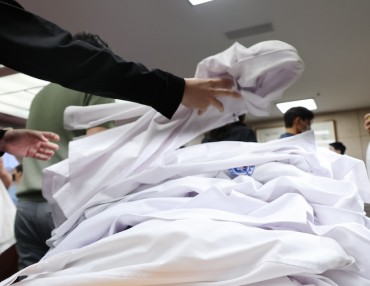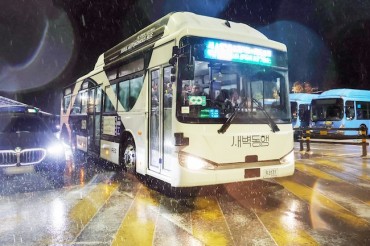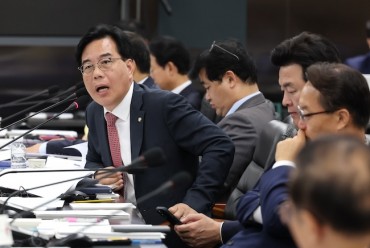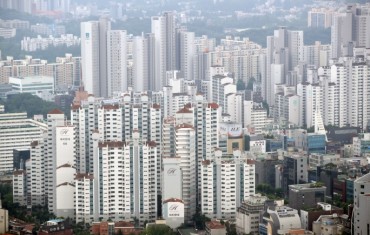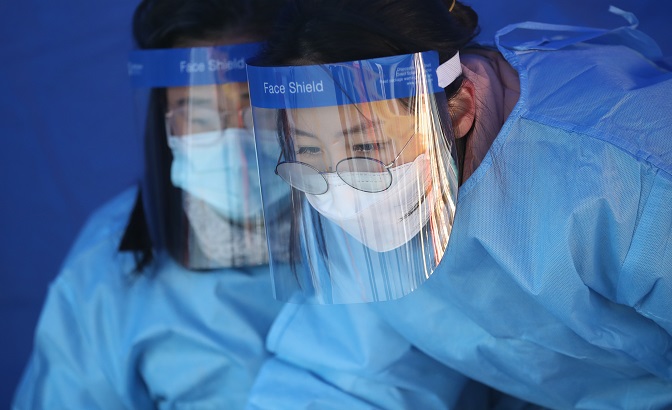
Officials prepare to carry out COVID-19 tests at a makeshift clinic in central Seoul on Dec. 14, 2020. (Yonhap)
SEOUL, Dec. 14 (Korea Bizwire) — South Korea’s daily new coronavirus cases fell back below 1,000 on Monday on fewer tests over the weekend after topping the mark for the first time the previous day, with health authorities struggling to conduct more virus tests to rein in further spread.
The country added 718 more COVID-19 cases, including 682 local infections, raising the total caseload to 43,484, according to the Korea Disease Control and Prevention Agency (KDCA).
On Sunday, the country reported its largest daily caseload ever of 1,030 new coronavirus cases, setting yet another fresh high after reporting 950 cases Saturday.
Over the past weeks, the country has reported hundreds of daily new cases due to locally transmitted cases from the greater Seoul area, which houses around half of the nation’s population.
Health authorities warned that the country’s daily virus caseload may spike to 1,200 should the current pace be maintained.
The KDCA said the nation’s reproduction rate for COVID-19 reached 1.28, indicating a patient infects more than one person.
“With the winter being here, we are now experiencing the third wave of the COVID-19 pandemic,” KDCA chief Jeong Eun-kyeong said during a daily briefing.
“Compared with the previous waves, the latest uptick in the number of cases is traced to various sources that have been accumulated for 10 months.”
Jeong stressed that the country can reduce the number of newly confirmed virus cases via social distancing schemes. “There is room for us to have fewer than estimated virus cases if we strictly follow toughened virus curbs and trace potential cases,” she said.
As of 6 p.m., the daily number of new COVID-19 cases was reported at 582, up 55 from the same time the previous day, according to municipal governments. The greater Seoul area identified 375 new cases, accounting for 64.4 percent of the total.
The daily average number of new COVID-19 cases came to 662 over the past week, soaring from 487.7 posted a week earlier. The number of new patients aged 60 and above came to 219 over the past week, according to the KCDC.
Over the past two weeks, cluster infections accounted for 22.8 percent of additional cases. Authorities are investigating transmission routes for 23.8 percent of the newly identified infections as well.
Gatherings among families and acquaintances accounted for more than 20 percent of such cluster infections.
Starting Monday, health authorities are providing free COVID-19 tests at 150 makeshift clinics in the wider Seoul area through Jan. 3, even to those who have not come into contact with patients, to keep track of asymptomatic patients.
People can also receive tests without providing personal information other than their mobile numbers.
South Korea had been touted as one of most successful countries in coping with COVID-19 despite ups and downs, maintaining most of its economic activities without a full lockdown.
After hitting the previous record of 909 on Feb. 29 due to cases traced to a minor church sect in Daegu, the daily figures were mostly in either two digits or below 400 before spiking since late November.
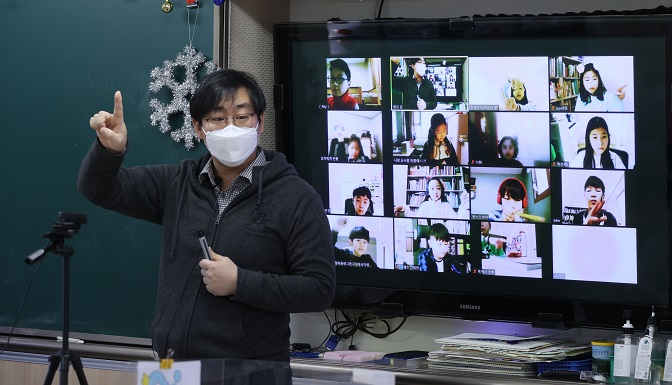
A teacher holds a virtual class with students at an elementary school in northern Seoul on Dec. 14, 2020. All elementary schools in Seoul are obligated to hold virtual classes by the end of this year amid the spike in the number of COVID-19 cases in the greater Seoul area. (Yonhap)
The country toughened social distancing measures, currently at Level 2.5, the second highest under the five-tier virus restrictions, last week, but the move has failed to curb a spike in new cases.
This week is anticipated to serve as a critical juncture for South Korea on whether it should adopt the highest level of its social distancing scheme, which can be implemented when locally transmitted cases surge to 800 to 1,000 or the daily tally doubles from the previous day.
Level 3 social distancing is less stringent than the lockdown measures adopted in the United States and Europe, but it is aimed at effectively minimizing social and business activities in a wide range of areas.
Any gatherings of 10 or more people will be banned under Level 3. All sports events will also be suspended, and schools can only offer online classes.
The Level 2.5 social distancing scheme allowed gatherings of less than 50 people and sports events without spectators.
Trains and express buses will also be obligated to fill only half of their seats. People are basically advised to stay at home as much as possible, and companies are required to have nonessential employees work from home.
South Korea, however, is cautious about adopting the highest level, as it will come at a great price in terms of the economy.
“The Level 3 social distancing scheme will become our last resort,” Prime Minister Chung Sye-kyun said during a meeting Monday.
“Raising the social distancing measure needs a careful review, and we also need to have a strong belief over its effectiveness and earn social consensus.
“For now, it is important that all people follow the enhanced anti-virus measures currently in force,” he said, pointing out the country will not hesitate to make drastic decisions when necessary.
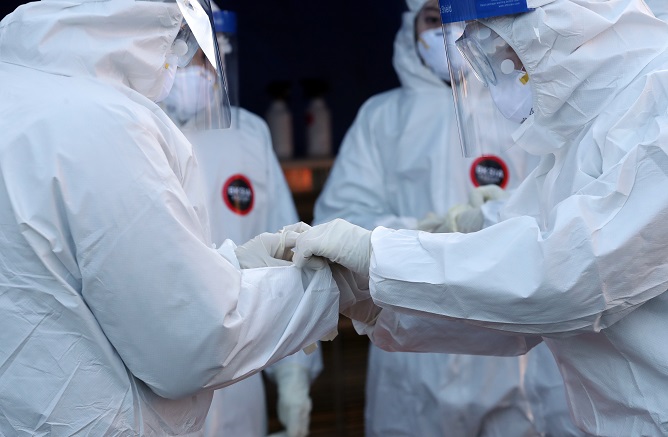
Officials prepare to carry out COVID-19 tests at a makeshift clinic in central Seoul on Dec. 14, 2020. (Yonhap)
Of the locally transmitted cases, the capital city of Seoul accounted for 217 cases, and the surrounding Gyeonggi Province took up 220. Incheon, west of Seoul, had 36 new cases.
Outside of greater Seoul, the southeastern port city of Busan reported 19 additional cases, followed by the southeastern city of Daegu with 16, South Gyeongsang Province with 26 and South Chungcheong Province with 51.
From west of Seoul, a religious facility added 22 more patients, raising the total to 162 as of Monday noon.
A restaurant from central Seoul reported four more patients. So far, a whopping 280 cases have been traced to the business.
A nursing home from Gyeonggi Province identified 17 more cases from the previous day, with the combined caseload reaching 18.
Cases traced to a religious facility from South Chungcheong Province came to 43, the KDCA data showed.
Imported cases came to 36.
Among the imported cases, patients from Russia and Indonesia accounted for seven each. Six were from the United States, and four cases were traced to South Africa.
The number of seriously or critically ill COVID-19 patients came to 185, up six from the previous day.
The KDCA reported seven additional deaths, raising the total to 587.
The fatality rate reached 1.35 percent.
The number of people released from quarantine after making full recoveries came to 288, raising the total to 32,102. This indicates around 74 percent of the patients reported here have been cured.
So far, 1.28 percent of COVID-19 tests here turned out to be positive, according to the KDCA data.
South Korea has carried out 3.39 million virus tests since January, with 3.26 million of them found to be negative. Around 89,000 tests are currently awaiting results.
The number of tests carried out Sunday came to 22,444, which marked a drastic decrease from 38,651 tests conducted on Friday last week, possibly indicating that the actual number of additional COVID-19 patients could be higher than thought.
The KDCA said the country plans to complete supply deals with at least two more companies by the end of this month.
“We believe that the locally produced vaccines developed by AstraZeneca will become the first batch to be provided to people, starting March (next year),” Jeong said. “We are continuing negotiations with other suppliers.”
The country’s health ministry said last week that the country has secured early access to COVID-19 vaccines developed by four pharmaceutical companies and from a global vaccine project for 44 million people.
South Korea said it has completed the deal with AstraZeneca Inc. and is in the process of finalizing the agreement with other suppliers, namely Pfizer, Johnson & Johnson’s Janssen and Moderna.
(Yonhap)



